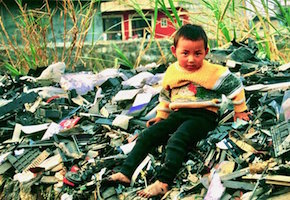
Environmental Progress is an activist and lobbying group out of California. NO STOP! They’re sensible! They support clean nuclear energy.
Their researchers Jemin Desai and Mark Nelson have identified a possible environmental crisis. (The Law of Unintended Consequences strikes again.) Just as we discover the “eco-friendly” Tesla car battery releases as much CO2 as EIGHT years of gasoline driving JUST IN PRODUCTION, now we discover that solar panel waste is filthy, toxic, and ground and air polluting. And it’s growing so fast it can’t be dealt with. This is in addition to the massive amounts of electronics waste that’s being exported to poor countries where despite Basel Convention Hazardous Waste trade regulations, some dubious recycling companies cut costs by offloading dismantling and recycling to impoverished countries with lax labor laws, weak environmental regulations, and poor human rights track records.
As a result of this massive, global flow of e-waste, former farming villages in countries like Vietnam, China, and Nigeria are now e-waste dumps.
In these impoverished communities, “recycling” often means burning circuit boards, soaking microchips in acid, and burning plastics to sort them by order. In short, it means poisoning people and the planet.
Here we look at the impact of that most smug of alternative energy industries: Solar Power.
Last November, Japan’s Environment Ministry issued a stark warning: the amount of solar panel waste Japan produces every year will rise from 10,000 to 800,000 tons by 2040, and the nation has no plan for safely disposing of it.
Neither does California, a world leader in deploying solar panels. Only Europe requires solar panel makers to collect and dispose of solar waste at the end of their lives.
All of which begs the question: just how big of a problem is solar waste?
Environmental Progress investigated the problem to see how the problem compared to the much more high-profile issue of nuclear waste.
We found:
- Solar panels create 300 times more toxic waste per unit of energy than do nuclear power plants.
- If solar and nuclear produce the same amount of electricity over the next 25 years that nuclear produced in 2016, and the wastes are stacked on football fields, the nuclear waste would reach the height of the Leaning Tower of Pisa (52 meters), while the solar waste would reach the height of two Mt. Everests (16 km).
- In countries like China, India, and Ghana, communities living near e-waste dumps often burn the waste in order to salvage the valuable copper wires for resale. Since this process requires burning off the plastic, the resulting smoke contains toxic fumes that are carcinogenic and teratogenic (birth defect-causing) when inhaled.

The study defines as toxic waste the spent fuel assemblies from nuclear plants and the solar panels themselves, which contain similar heavy metals and toxins as other electronics, such as computers and smartphones.
To make these calculations, EP estimated the total number of operational solar panels in 2016 and assumed they would all be retired in 25 years — the average lifespan of a solar panel. EP then estimated the total amount of spent nuclear fuel assemblies that would be generated over a 25 year period. EP then divided both estimates by the quantity of electricity they produced to come up with the waste per unit of energy measure.
While nuclear waste is contained in heavy drums and regularly monitored, solar waste outside of Europe today ends up in the larger global stream of electronic waste.
Solar panels contain toxic metals like lead, which can damage the nervous system, as well as chromium and cadmium, known carcinogens. All three are known to leach out of existing e-waste dumps into drinking water supplies.
The deployment of solar has increased significantly in recent years in response to government subsidies and mandates. Global installed capacity more than doubled between 2012 and 2015.
In 2016, solar provided 1.3% of the world’s electricity, with 301 GW installed. Nuclear reactors provided 10% of the world’s electricity in the same year.
A recent report found that it would take 19 years for Toshiba Environmental Solutions to finish recycling all of the solar waste Japan produced by 2020. By 2034, the annual waste production will be 70 – 80 times larger than that of 2020.
Original article here: http://www.environmentalprogress.org/big-news/2017/6/21/are-we-headed-for-a-solar-waste-crisis